Standardization of Power-from-Shore Grid Connections for Offshore Oil & Gas Production
Abstract
:1. Introduction
1.1. Hypothesis
1.2. Research Plan
- To what degree can offshore infrastructure benefit from standardization?
- What is the impact of standardization on the overall cost and reliability?
- What is the potential and solutions for a larger scale deployment?
- An estimation of the power requirements of offshore O&G sites based on the installed base;
- A design of an optioneering model to select adequate AC or DC voltage level and cables;
- The definition of a limited set of AC and DC power/voltage envelopes towards standardization.
1.3. Paper Organization
2. Literature Review
3. Research Material
3.1. OHVS and PFS Installed Base
3.2. Evaluation of O&G Portfolio
4. Research Method
4.1. Cable Portfolio
4.2. Model Reference Data
4.3. HVAC Transmission Model
4.4. HVAC Transmission Initial Conditions and Triggers
| Regulation or Guideline | Document Description |
|---|---|
| DNVGL-ST-0145 | Offshore substations |
| DNVGL-RP-0046 | Qualification of HVDC technologies |
| DNVGL-RP-0423 | Manufacturing and commissioning of offshore substations |
| DNVGL-ST-0359 | Subsea power cables for wind power plants |
| DNVGL-RP-F401 | Electrical power cables in subsea applications |
| CIGRE Technical Brochure 483 | Guidelines for the design and construction of AC OSS for WPP |
| DNV-OS-J201 | Offshore substations for wind farms |
| Commission Regulation (EU) 2016/631 ENTSO-E | Network code on requirements for generators |
| Variable | Units | Initial Value | Comments | References |
|---|---|---|---|---|
| Rated voltage | % | 100 | ||
| Cable de-rating | % | 80 | Combined factor due to installation conditions (e.g., temperature, depth, pressure, etc.) | [49,52] |
| Cable loading | % | 80 | ||
| Power factor | N/A | 1.0 | Typical power factor at offshore production facilities is 0.7 | [53] |
| Trigger | Units | Trigger Value | Comments | References |
|---|---|---|---|---|
| Max./Min. Voltage | % | 90–105 | Voltage stability requirement for AC-connected offshore power park modules | [54] |
| Cable rating | % | 100 | Current shall not exceed the thermal limit inclusive of any de-rating factors | [50] |
| No-load current | % | 100 | Current shall not exceed the thermal limit inclusive of any de-rating factors | [50,55] |
| No-load voltage | % | 95–105 | Voltage stability requirement for AC-connected offshore power park modules | [54,55] |
| Static stability | º | 30 | The voltage angles between the remote ends shall not lead to loss of synchronization | [50] |
4.5. HVDC Transmission Model
4.6. Optioneering Model
4.7. Cost Models for HVAC and HVDC
| Land Cable (Supply and Installation) [MUSD/MVA × km] | Submarine Cable (Supply and Installation) [MUSD/MVA × km] | Onshore Substation (EPCI) [MUSD/MW] | Offshore Substation (EPCI) [MUSD/MW] | VAR Compensation (SVC-Type) [MUSD/MVAr] | Development and Other Costs [%] |
|---|---|---|---|---|---|
| 4.4 | 4.6 | 0.054 | 0.194 | 0.1 | 9.0 |
| Land Cable (Supply & Installation) [MUSD/MVA × km] | Submarine Cable (Supply & Installation) [MUSD/MVA × km] | Onshore Substation (EPCI) [MUSD/MW] | Offshore Substation (EPCI) [MUSD/MW] | Development and Other Costs [%] |
|---|---|---|---|---|
| 2.9 | 3.1 | 0.137 | 0.277 | 9.0 |
4.8. Objective Function
5. Results
5.1. Model Validation
5.2. Model Results
5.3. HVAC and HVDC Modules
6. Conclusions
Author Contributions
Funding
Institutional Review Board Statement
Informed Consent Statement
Data Availability Statement
Conflicts of Interest
Abbreviations
| Acronym | Full Name |
| ABCD | Transmission Line Model Parameters (Admittance Matrix) |
| AC | Alternating Current |
| BoE | Barrel of Oil-Equivalent |
| CAPEX | Capital Expenditure |
| CIGRÉ | International Council on Large Electric Systems |
| CO2 | Carbon Dioxide |
| DC | Direct Current |
| DNV-GL | Det Norske Veritas—Germanischer Lloyd |
| ENTSO-E | European Network of Transmission System Operators |
| EPCI | Engineering, Procurement, Construction and Installation |
| FCT | Fundação para a Ciência e a Tecnologia |
| GIS | Gas-Insulated Switchgear |
| HVAC | High Voltage Alternated Current |
| HVDC | High Voltage Direct Current |
| LCA | Life-Cycle Assessment |
| LCC | Line-Commutated Converter |
| LCOE | Levelized Cost of Energy |
| MMC | Modular Multilevel Converter |
| MV | Medium Voltage |
| MVDC | Medium Voltage Direct Current |
| O&G | Oil and Gas |
| OFGEM | Great Britain’s Office of Gas and Electricity Markets |
| OHVS | Offshore High Voltage Substation(s) |
| OPEC | Organization of the Petroleum Exporting Countries |
| OPEX | Operational Expenditure |
| OTM | Offshore Transformer Module |
| OWF | Offshore Wind Farm |
| PFS | Power from Shore |
| PoW | Point-on-Wave |
| STATCOM | Static Synchronous VAR Compensation |
| SVC | Static Var Compensation |
| TSO | Transmission System Operator |
| VAr | Reactive Power |
| VSC | Voltage-Sourced Converter |
Nomenclature
| Variable | Full Variable Description (Units) |
| Active Power at reception (remote end or offshore) (MVA) | |
| Active Power Flow (MW) | |
| Admittance of reactive power compensation system (S) | |
| Cost factor per unit of Active Power (Euro/MW) | |
| Cost factor per unit of Active Power and Distance (Euro/MW.km) | |
| Cost factor per unit of Cost (%/Total Cost) | |
| Cost factor per unit of Distance (Euro/km) | |
| Current at emission (local end or onshore (A) | |
| Current at reception (remote end or offshore) (A) | |
| Difference between Voltage Angle at emission and reception (º) | |
| Distance at the point of fault trigger (km) | |
| Distance at the point of fault trigger for each variable n under review (km) | |
| Equivalent oil production of O&G offshore site (BoE) | |
| Interpolated values of distance (km) | |
| Interpolated values of variable (variable units) | |
| Line Conductance (S/km) | |
| Line Current (ADC) | |
| Line Impedance (Ω/km) | |
| Line Susceptance (S/km) | |
| Line Voltage (kVDC) | |
| Longitudinal Impedance (Ω) | |
| Maximum current for selected cable k per-phase (A) | |
| Maximum distance for that cable solution k is feasible (km) | |
| No-Load Current (local end or onshore) (A) | |
| No-Load Voltage (remote end or offshore) (kV) | |
| OS | Optimal solution (per candidate) (Euro) |
| Power requirement for O&G offshore site (MW) | |
| Ratio between the reactive power compensation required and adjusted | |
| Reactive Power at reception (remote end or offshore) (MVAR) | |
| Reactive power compensation calculated (under boundary conditions) at (MVAR) | |
| Reactive power compensation required for scenario (MVAR) | |
| Resistance per-km (DC cable) (Ω/km) | |
| Resistance per-km (Ω/km) | |
| Total cost of candidate (Euro) | |
| Total cost using AC solution (for candidate) (Euro) | |
| Total cost using AC solution including Reactive Compensation (for candidate) (Euro) | |
| Total cost using DC solution (for candidate) (Euro) | |
| Transverse Admittance (S) | |
| Variable value at the point of fault trigger (variable units) | |
| Voltage Angle at emission (local end)/reception (remote end) (°) | |
| Voltage at emission (local end or onshore) (kV) | |
| Voltage at reception (remote end or offshore) (kV) |
References
- Oliveira-Pinto, S.; Rosa-Santos, P.; Taveira-Pinto, F. Electricity supply to offshore oil and gas platforms from renewable ocean wave energy: Overview and case study analysis. Energy Convers. Manag. 2019, 186, 556–569. [Google Scholar] [CrossRef]
- Oliveira-Pinto, S.; Rosa-Santos, P.; Taveira-Pinto, F. Assessment of the potential of combining wave and solar energy resources to power supply worldwide offshore oil and gas platforms. Energy Convers. Manag. 2020, 223, 113299. [Google Scholar] [CrossRef]
- Marvik, J.I.; Øyslebø, E.V.; Korpås, M. Electrification of offshore petroleum installations with offshore wind integration. Renew. Energy 2013, 50, 558–564. [Google Scholar] [CrossRef]
- Riboldi, L.; Nord, L.O. Concepts for lifetime efficient supply of power and heat to offshore installations in the North Sea. Energy Convers. Manag. 2017, 148, 860–875. [Google Scholar] [CrossRef]
- Korpås, M.; Warland, L.; He, W.; Tande, J.O.G. A Case-Study on Offshore Wind Power Supply to Oil and Gas Rigs. Energy Procedia 2012, 24, 18–26. [Google Scholar] [CrossRef] [Green Version]
- Hamdan, H.A.; Kinsella, B. Using a VSC Based HVDC Application to Energize Offshore Platforms from Onshore—A Life-cycle Economic Appraisal. Energy Procedia 2017, 105, 3101–3111. [Google Scholar] [CrossRef]
- Hamadi, V.; Brosnan, U.; Loftus, I.; Montgomery, G. Offshore Substation Design: High-Level Overview of the Industry Best Practices. IEEE Power Energy Mag. 2019, 17, 67–74. [Google Scholar] [CrossRef]
- Antunes, T.A.; Santos, P.J.; Pires, A.J. HVAC transmission restrictions in large scale offshore wind farm applications. In Proceedings of the 2017 11th IEEE International Conference on Compatibility, Power Electronics and Power Engineering, CPE-POWERENG 2017, Cadiz, Spain, 4–6 April 2017; pp. 46–52. [Google Scholar] [CrossRef]
- Jansen, M.; Duffy, C.; Green, T.C.; Staffell, I. Island in the Sea: The prospects and impacts of an offshore wind power hub in the North Sea. Adv. Appl. Energy 2022, 6, 100090. [Google Scholar] [CrossRef]
- Ruddy, J.; Meere, R.; O’Donnell, T. Low Frequency AC transmission for offshore wind power: A review. Renew. Sustain. Energy Rev. 2016, 56, 75–86. [Google Scholar] [CrossRef]
- Soares-Ramos, E.P.; Assis, L.D.O.; Sarrias-Mena, R.; Fernández-Ramírez, L.M. Current status and future trends of offshore wind power in Europe. Energy 2020, 202, 117787. [Google Scholar] [CrossRef]
- Härtel, P.; Vrana, T.K.; Hennig, T.; von Bonin, M.; Wiggelinkhuizen, E.J.; Nieuwenhout, F.D. Review of investment model cost parameters for VSC HVDC transmission infrastructure. Electr. Power Syst. Res. 2017, 151, 419–431. [Google Scholar] [CrossRef] [Green Version]
- Houghton, T.; Bell, K.R.W.; Doquet, M. Offshore transmission for wind: Comparing the economic benefits of different offshore network configurations. Renew. Energy 2016, 94, 268–279. [Google Scholar] [CrossRef] [Green Version]
- Salari, M.E.; Coleman, J.; Toal, D. Analysis of direct interconnection technique for offshore airborne wind energy systems under normal and fault conditions. Renew. Energy 2018, 131, 284–296. [Google Scholar] [CrossRef]
- Nieradzinska, K.; MacIver, C.; Gill, S.; Agnew, G.; Anaya-Lara, O.; Bell, K. Optioneering analysis for connecting Dogger Bank offshore wind farms to the GB electricity network. Renew. Energy 2016, 91, 120–129. [Google Scholar] [CrossRef] [Green Version]
- Elliott, D.; Bell, K.R.W.; Finney, S.J.; Adapa, R.; Brozio, C.; Yu, J.; Hussain, K. A Comparison of AC and HVDC Options for the Connection of Offshore Wind Generation in Great Britain. IEEE Trans. Power Deliv. 2015, 31, 798–809. [Google Scholar] [CrossRef] [Green Version]
- Roses, A.P.; Francois, B. Practical determination of HVAC—HVDC Hybridization ratio for Offshore Transmission network Architectures through technico-economic considerations. IFAC-PapersOnLine 2016, 49, 425–432. [Google Scholar] [CrossRef]
- Ackermann, T. Transmission Systems for Offshore Wind Farms. In Wind Power in Power Systems; John Wiley & Sons: Hoboken, NJ, USA, 2005; pp. 479–503. [Google Scholar] [CrossRef]
- Zhang, Y.; Ravishankar, J.; Fletcher, J.; Li, R.; Han, M. Review of modular multilevel converter based multi-terminal HVDC systems for offshore wind power transmission. Renew. Sustain. Energy Rev. 2016, 61, 572–586. [Google Scholar] [CrossRef]
- Alassi, A.; Bañales, S.; Ellabban, O.; Adam, G.; MacIver, C. HVDC Transmission: Technology Review, Market Trends and Future Outlook. Renew. Sustain. Energy Rev. 2019, 112, 530–554. [Google Scholar] [CrossRef]
- Pierri, E.; Binder, O.; Hemdan, N.G.; Kurrat, M. Challenges and opportunities for a European HVDC grid. Renew. Sustain. Energy Rev. 2017, 70, 427–456. [Google Scholar] [CrossRef]
- Carrizosa, M.J.; Navas, F.D.; Damm, G.; Lamnabhi-Lagarrigue, F. Optimal power flow in multi-terminal HVDC grids with offshore wind farms and storage devices. Int. J. Electr. Power Energy Syst. 2015, 65, 291–298. [Google Scholar] [CrossRef]
- Korompili, A.; Wu, Q.; Zhao, H. Review of VSC HVDC connection for offshore wind power integration. Renew. Sustain. Energy Rev. 2016, 59, 1405–1414. [Google Scholar] [CrossRef] [Green Version]
- Gomis-Bellmunt, O.; Liang, J.; Ekanayake, J.; King, R.; Jenkins, N. Topologies of multiterminal HVDC-VSC transmission for large offshore wind farms. Electr. Power Syst. Res. 2011, 81, 271–281. [Google Scholar] [CrossRef]
- Liang, J.; Gomis-Bellmunt, O.; Ekanayake, J.; Jenkins, N.; An, W. A multi-terminal HVDC transmission system for offshore wind farms with induction generators. Int. J. Electr. Power Energy Syst. 2012, 43, 54–62. [Google Scholar] [CrossRef]
- Sutton, S.J.; Lewin, P.L.; Swingler, S.G. Review of global HVDC subsea cable projects and the application of sea electrodes. Int. J. Electr. Power Energy Syst. 2017, 87, 121–135. [Google Scholar] [CrossRef]
- Negra, N.B.; Todorovic, J.; Ackermann, T. Loss evaluation of HVAC and HVDC transmission solutions for large offshore wind farms. Electr. Power Syst. Res. 2006, 76, 916–927. [Google Scholar] [CrossRef]
- de Alegría, I.M.; Martín, J.L.; Kortabarria, I.; Andreu, J.; Ereño, P.I. Transmission alternatives for offshore electrical power. Renew. Sustain. Energy Rev. 2009, 13, 1027–1038. [Google Scholar] [CrossRef]
- Westman, B.; Gilje, S.; Hyttinen, M. Valhall Re-Development Project, Power From Shore. İn PCIC Europe Petroleum and Chemical Industry Conference Europe—Electrical and Instrumentation Applications. 2010. Available online: https://ieeexplore.ieee.org/document/5525737 (accessed on 28 November 2020).
- Myklebust, H.; Eriksson, K.; Westman, B.; Persson, G. Valhall power from shore after five years of operation. In Proceedings of the 2017 Petroleum and Chemical Industry Conference Europe (PCIC Europe), Vienna, Austria, 16–18 May 2017; pp. 1–4. [Google Scholar] [CrossRef]
- Thibaut, E.; Leforgeais, B. Selection of Power From Shore for an Offshore Oil and Gas Development. IEEE Trans. Ind. Appl. 2014, 51, 1333–1340. [Google Scholar] [CrossRef]
- El-Fouly, T.; Zeineldin, H.; El-Saadany, E.; Salama, M. A new optimization model for distribution substation siting, sizing, and timing. Int. J. Electr. Power Energy Syst. 2007, 30, 308–315. [Google Scholar] [CrossRef]
- González, J.S.; Payán, M.B.; Santos, J.R. Optimum design of transmissions systems for offshore wind farms including decision making under risk. Renew. Energy 2013, 59, 115–127. [Google Scholar] [CrossRef]
- Wang, L.; Wu, J.; Wang, T.; Han, R. An optimization method based on random fork tree coding for the electrical networks of offshore wind farms. Renew. Energy 2019, 147, 1340–1351. [Google Scholar] [CrossRef]
- Antunes, T.A.; Castro, R.; Santos, P.J.; Pires, A.J.; Foehr, M. Optimized Electrification of Subsea Oil & Gas Infrastructures Based in Genetic Algorithm. In Technological Innovation for Industry and Service Systems; Springer: Cham, Swizterland, 2019; pp. 214–223. [Google Scholar] [CrossRef]
- Santibanez-Borda, E.; Korre, A.; Nie, Z.; Durucan, S. A multi-objective optimisation model to reduce greenhouse gas emissions and costs in offshore natural gas upstream chains. J. Clean. Prod. 2021, 297, 126625. [Google Scholar] [CrossRef]
- Müller, H.; Torbaghan, S.S.; Gibescu, M.; Roggenkamp, M.; van der Meijden, M. The need for a common standard for voltage levels of HVDC VSC technology. Energy Policy 2013, 63, 244–251. [Google Scholar] [CrossRef]
- D’Souza, M.; Dhara, R.S.; Bouyer, R.C. Modularization of High Voltage Gas Insulated Substations. IEEE Trans. Ind. Appl. 2020, 56, 4662–4669. [Google Scholar] [CrossRef]
- Svendsen, H.G. Planning Tool for Clustering and Optimised Grid Connection of Offshore Wind Farms. Energy Procedia 2013, 35, 297–306. [Google Scholar] [CrossRef] [Green Version]
- Qin, C.; Li, B.; Shi, B.; Qin, T.; Xiao, J.; Xin, Y. Location of substation in similar candidates using comprehensive evaluation method base on DHGF. Measurement 2019, 146, 152–158. [Google Scholar] [CrossRef]
- Li, Y.; Liu, H.; Fan, X.; Tian, X. Engineering practices for the integration of large-scale renewable energy VSC-HVDC systems. Glob. Energy Interconnect. 2020, 3, 149–157. [Google Scholar] [CrossRef]
- McKenna, R.; D’Andrea, M.; González, M.G. Analysing long-term opportunities for offshore energy system integration in the Danish North Sea. Adv. Appl. Energy 2021, 4, 100067. [Google Scholar] [CrossRef]
- Zhang, A.; Zhang, H.; Qadrdan, M.; Li, X.; Li, Q. Energy Hub based Electricity Generation System Design for an Offshore Platform Considering CO 2 -Mitigation. Energy Procedia 2017, 142, 3597–3602. [Google Scholar] [CrossRef]
- Liu, Y.; Fu, Y.; Huang, L.-L.; Ren, Z.-X.; Jia, F. Optimization of offshore grid planning considering onshore network expansions. Renew. Energy 2021, 181, 91–104. [Google Scholar] [CrossRef]
- Jin, R.; Hou, P.; Yang, G.; Qi, Y.; Chen, C.; Chen, Z. Cable routing optimization for offshore wind power plants via wind scenarios considering power loss cost model. Appl. Energy 2019, 254, 113719. [Google Scholar] [CrossRef]
- Andersson, U.; Jubert, D.C.; Evers, T. Developing and Installing Substations for Oil and Gas Facilities in Very Cold and Remote Locations. IEEE Trans. Ind. Appl. 2011, 47, 1184–1192. [Google Scholar] [CrossRef]
- Offshore, C. Offshore Substation Database. Available online: https://www.4coffshore.com/transmission/substations.aspx (accessed on 6 October 2020).
- ABB. XLPE Land Cable Systems—User’s Guide. 2010. Available online: https://library.e.abb.com/public/ab02245fb5b5ec41c12575c4004a76d0/XLPE%20Land%20Cable%20Systems%202GM5007GB%20rev%205.pdf (accessed on 25 October 2010).
- ABB. XLPE Submarine Cable Systems—Attachment to XLPE Land Cable Systems—User’s Guide. 2010. Available online: https://new.abb.com/docs/default-source/ewea-doc/xlpe-submarine-cable-systems-2gm5007.pdf (accessed on 6 October 2020).
- Sucena Paiva, J.P. Redes de Energia Eléctrica: Uma Análise Sistémica; IST Press: Lisbon, Portugal, 2007. [Google Scholar]
- Equinor. Hywind Tampen: The World’s First Renewable Power for Offshore Oil and Gas. Available online: https://www.equinor.com/en/what-we-do/hywind-tampen.html (accessed on 15 January 2021).
- ABB. HVDC Light Cables; ABB: Zürich, Switzerland, 2006. [Google Scholar]
- Sutherland, P.E. Safe Operating Limits. IEEE Ind. Appl. Mag. 2011, 17, 14–19. [Google Scholar] [CrossRef]
- ENTSOE. Commission Regulation (EU) 2016/631 of 14 April 2016. Establishing a Network Code on Requirements for Grid Connection of Generators. 2016. Available online: https://www.entsoe.eu/network_codes/rfg/ (accessed on 15 January 2021).
- Conseil İnternational des Grands Réseaux Électriques. Guidelines for the Design and Construction of AC Offshore Substations for Wind Power Plants; Working Group B3.26; Cigré: Paris, France, 2011. [Google Scholar]
- Liu, R. Progress of long-distance DC electrical power transmission. In Proceedings of the 2017 1st International Conference on Electrical Materials and Power Equipment (ICEMPE), Xi’an, China, 14–17 May 2017; pp. 93–96. [Google Scholar] [CrossRef]
- Heier, S. Grid Integration of Wind Energy: Onshore and Offshore Conversion Systems. 2014. Available online: https://www.wiley.com/en-au/Grid+Integration+of+Wind+Energy%3A+Onshore+and+Offshore+Conversion+Systems%2C+3rd+Edition-p-9781119962946 (accessed on 15 January 2021).
- OFGEM. Offshore Transmission Cost Assessment Workshop: Development Proposals. 2013. Available online: https://www.ofgem.gov.uk/sites/default/files/docs/2013/12/13_dec_workshopslides.pdf (accessed on 15 January 2021).
- Offshore Renewable Energy Catapult. Guide to an Offshore Wind Farm: Wind Farm Costs. Available online: https://guidetoanoffshorewindfarm.com/wind-farm-costs (accessed on 15 January 2021).
- Nepsha, F.; Voronin, V.; Belyaevsky, R.; Efremenko, V.; Varnavskiy, K. Application of FACTS Devices in Power Supply Systems of Coal Mines. E3S Web Conf. 2020, 174, 03026. [Google Scholar] [CrossRef]
- Mæland, A.; Chokhawala, R.S. Powering Oil & Gas Offshore Operations from Mainland Electrical Grid. Available online: https://www.osti.gov/etdeweb/servlets/purl/21390200 (accessed on 15 January 2021).
- Connecting Offshore Wind Farms: A Comparison of Offshore Electricity Grid Development Models in Northwest Europe; Navigant Netherlands B.V.: Utrecht, The Netherlands, 2019.
- Van Hertem, D.; Leterme, W.; Chaffey, G.; Abedrabbo, M.; Wang, M.; Zerihun, F.; Barnes, M. Substations for Future HVdc Grids: Equipment and Configurations for Connection of HVdc Network Elements. IEEE Power Energy Mag. 2019, 17, 56–66. [Google Scholar] [CrossRef] [Green Version]
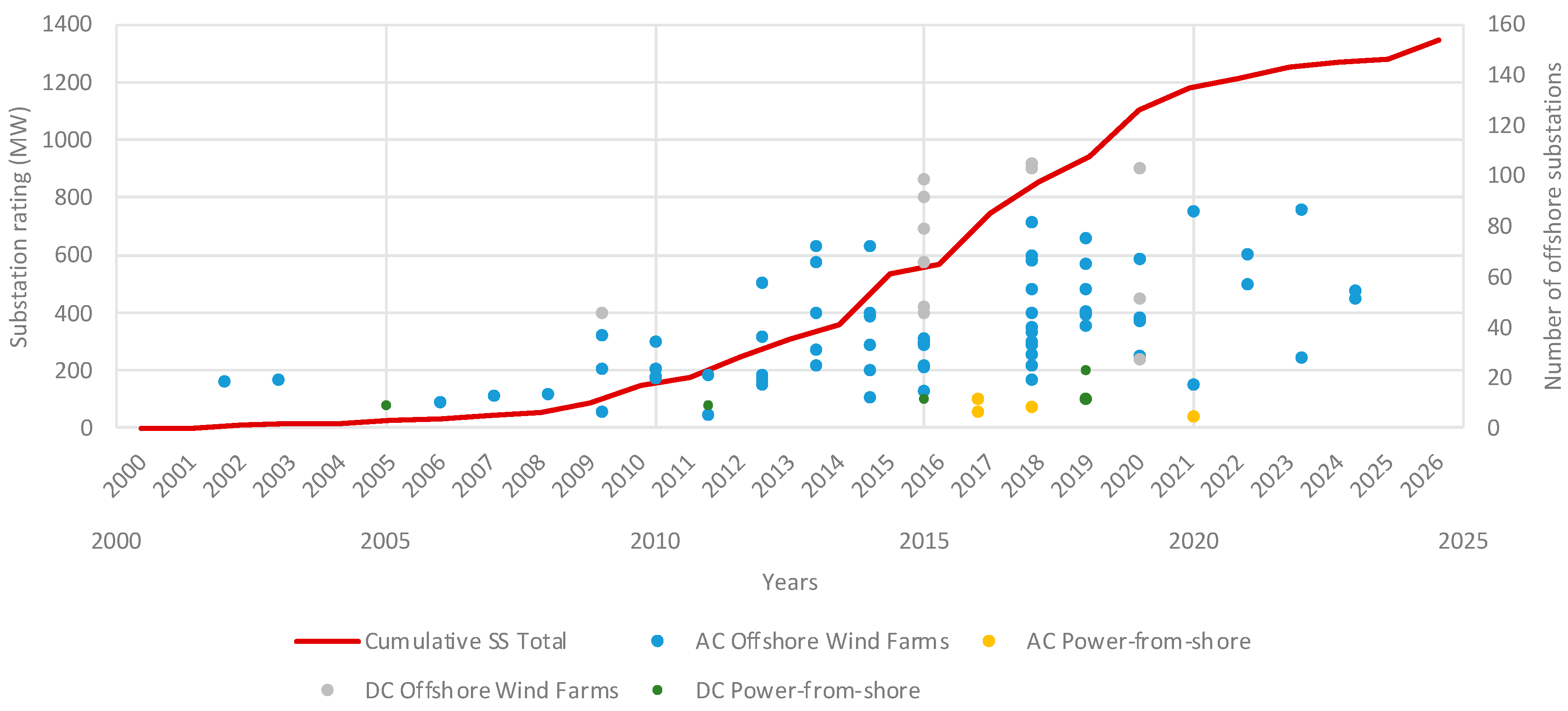
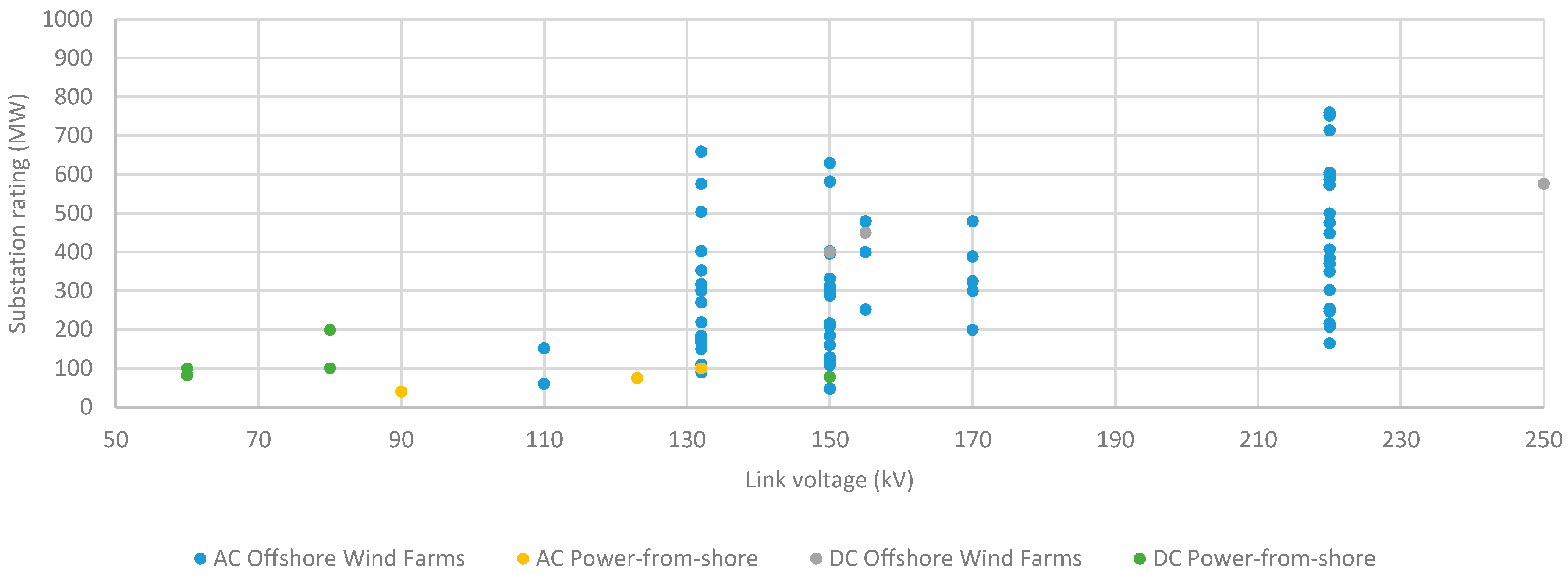
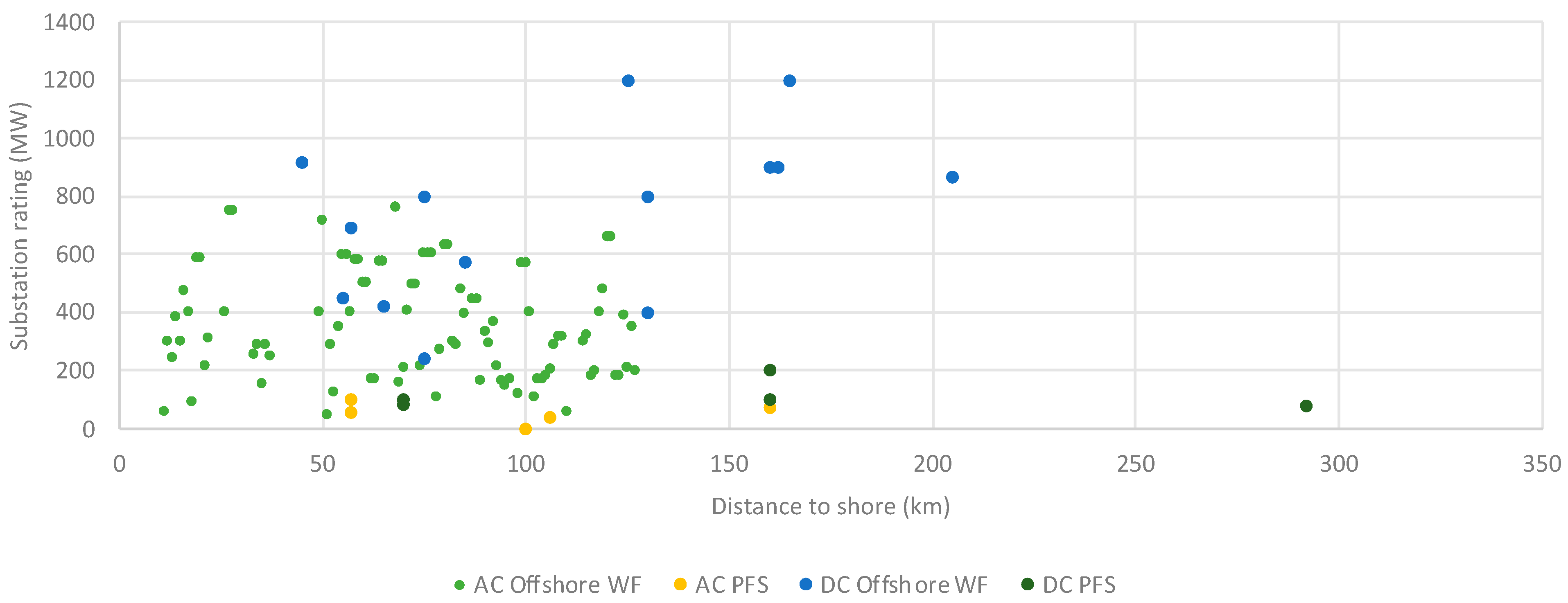

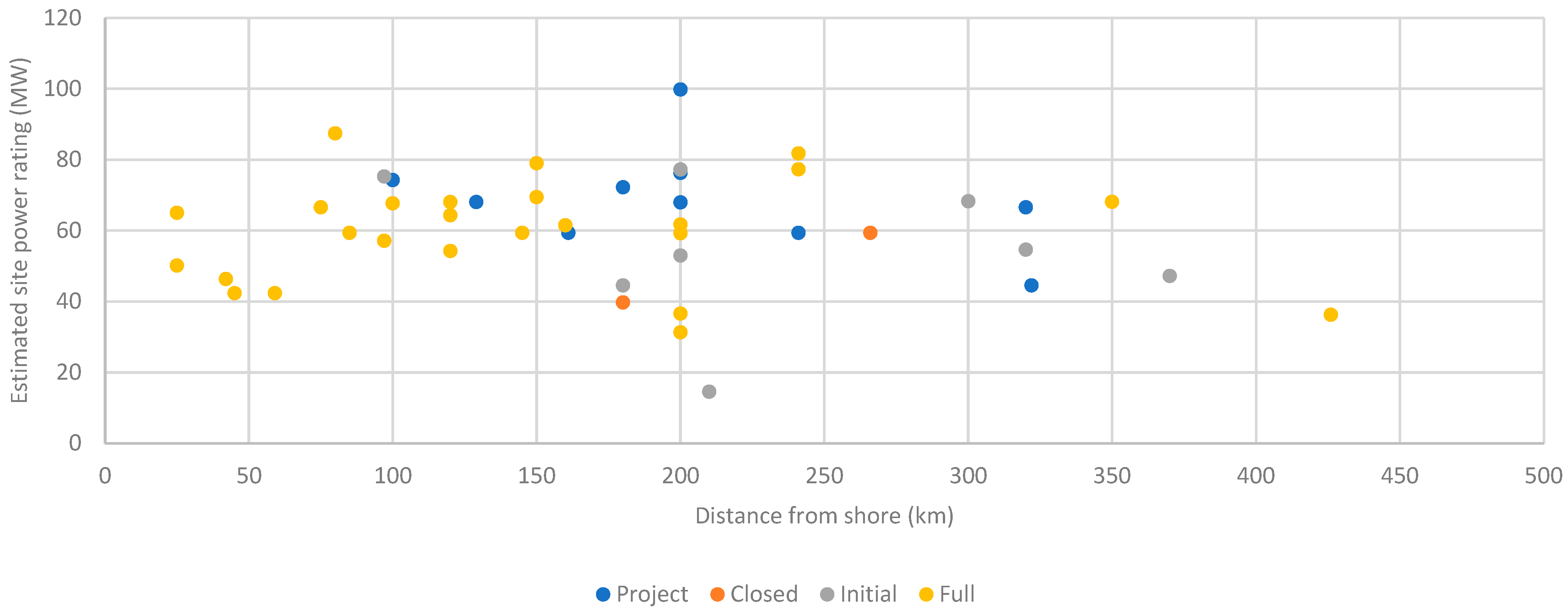
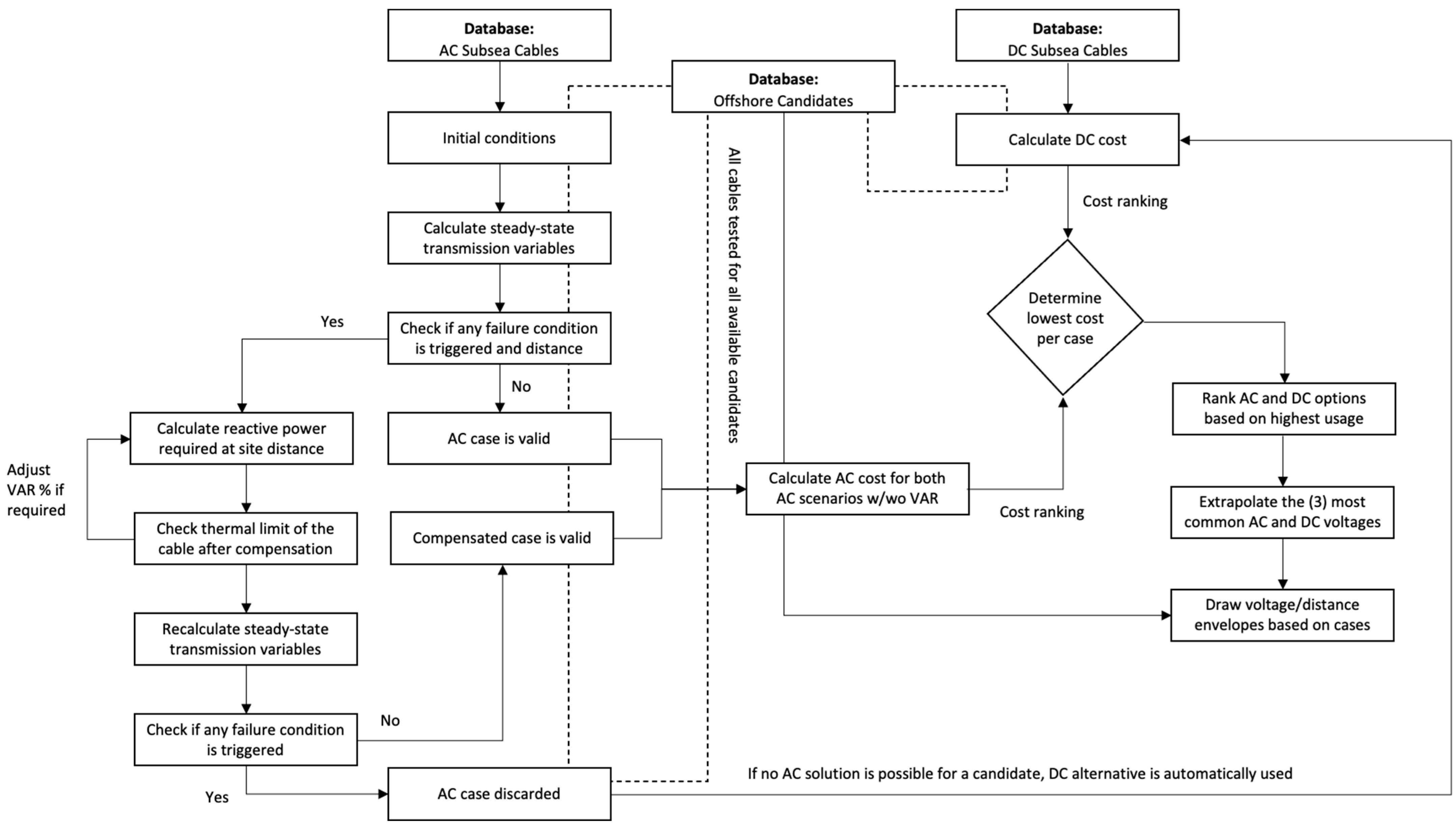

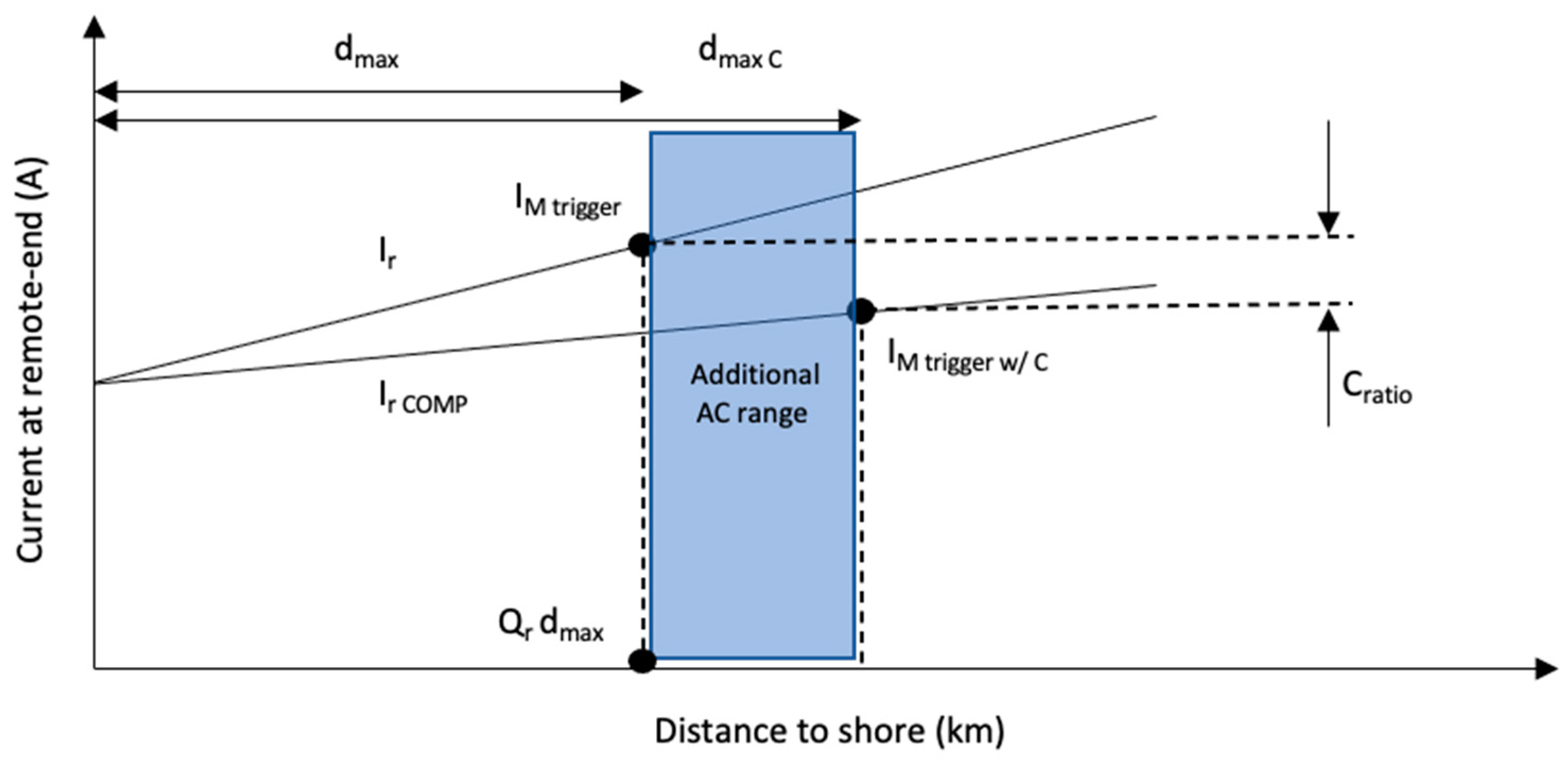

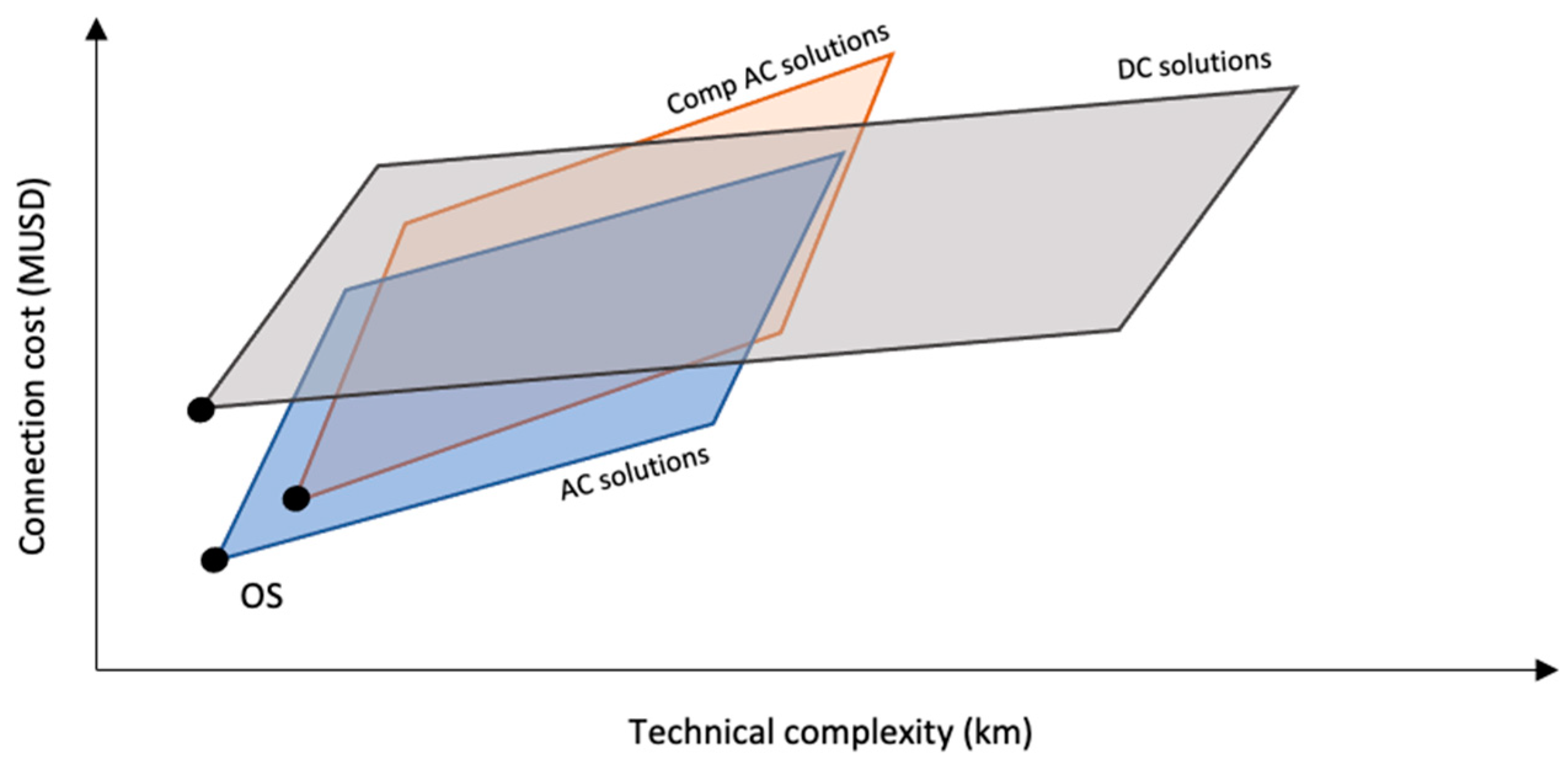
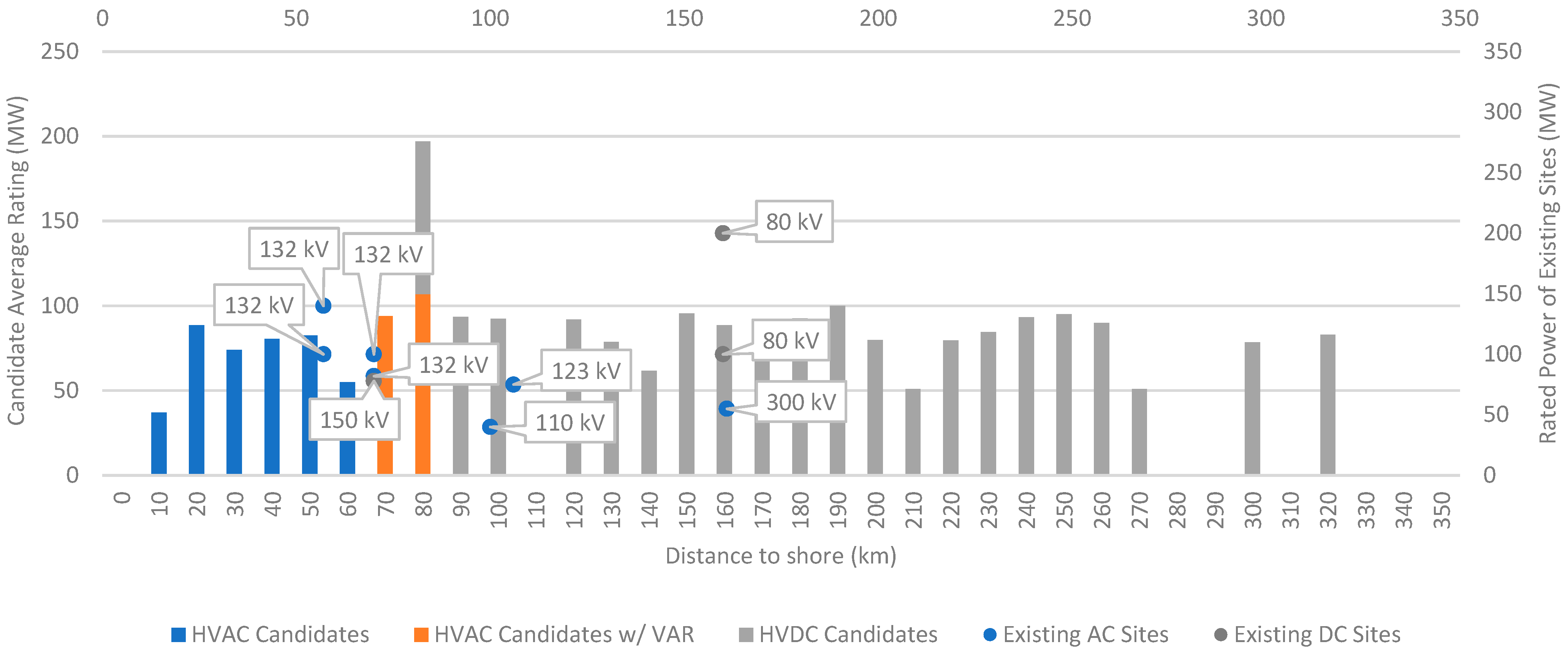


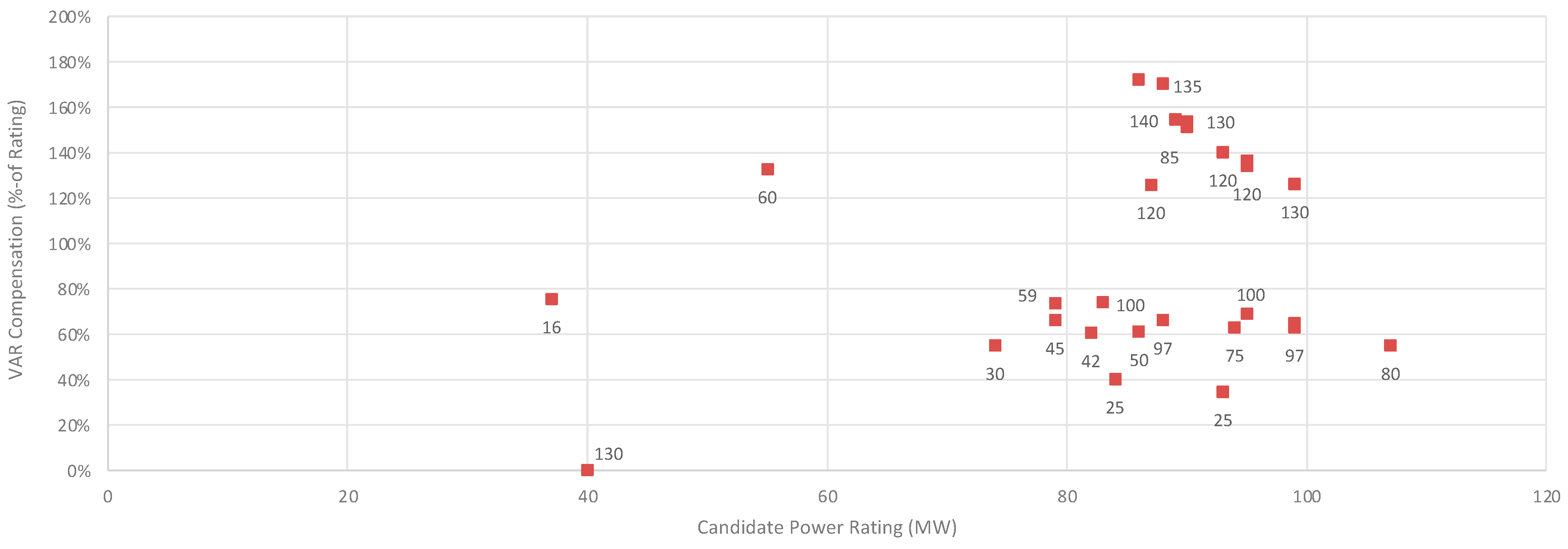

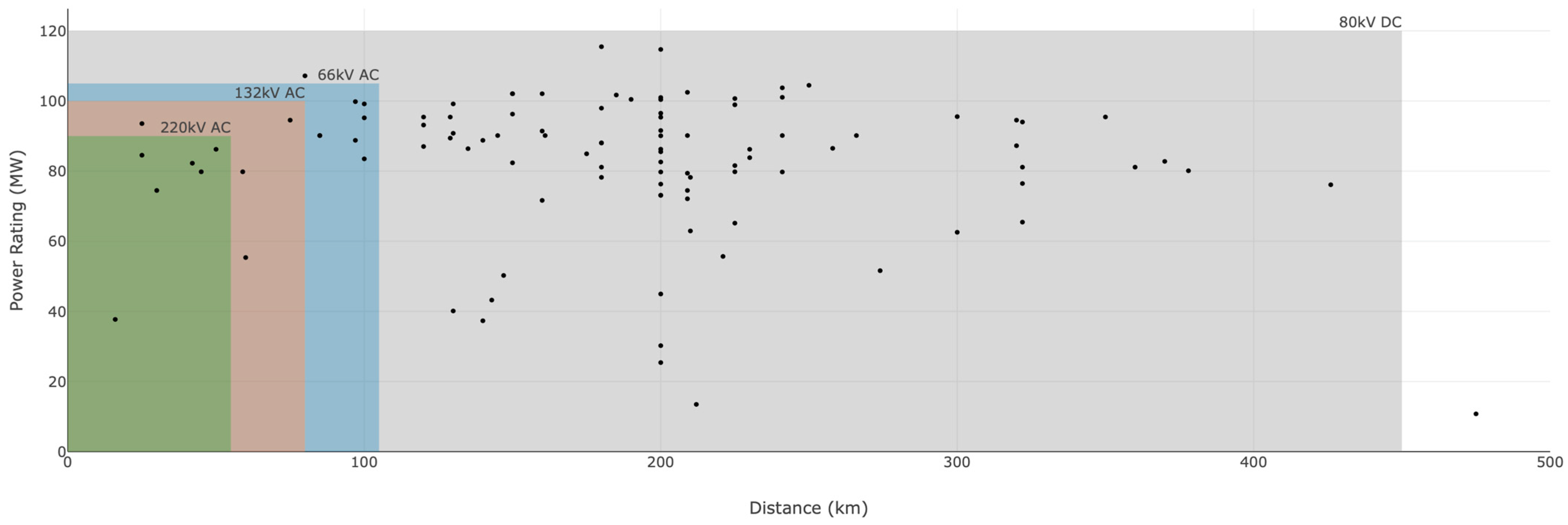
Disclaimer/Publisher’s Note: The statements, opinions and data contained in all publications are solely those of the individual author(s) and contributor(s) and not of MDPI and/or the editor(s). MDPI and/or the editor(s) disclaim responsibility for any injury to people or property resulting from any ideas, methods, instructions or products referred to in the content. |
© 2023 by the authors. Licensee MDPI, Basel, Switzerland. This article is an open access article distributed under the terms and conditions of the Creative Commons Attribution (CC BY) license (https://creativecommons.org/licenses/by/4.0/).
Share and Cite
Antunes, T.A.; Castro, R.; Santos, P.J.; Pires, A.J. Standardization of Power-from-Shore Grid Connections for Offshore Oil & Gas Production. Sustainability 2023, 15, 5041. https://doi.org/10.3390/su15065041
Antunes TA, Castro R, Santos PJ, Pires AJ. Standardization of Power-from-Shore Grid Connections for Offshore Oil & Gas Production. Sustainability. 2023; 15(6):5041. https://doi.org/10.3390/su15065041
Chicago/Turabian StyleAntunes, Tiago A., Rui Castro, Paulo J. Santos, and Armando J. Pires. 2023. "Standardization of Power-from-Shore Grid Connections for Offshore Oil & Gas Production" Sustainability 15, no. 6: 5041. https://doi.org/10.3390/su15065041
APA StyleAntunes, T. A., Castro, R., Santos, P. J., & Pires, A. J. (2023). Standardization of Power-from-Shore Grid Connections for Offshore Oil & Gas Production. Sustainability, 15(6), 5041. https://doi.org/10.3390/su15065041








